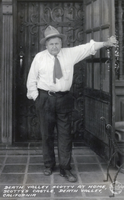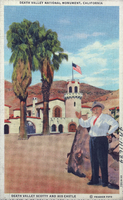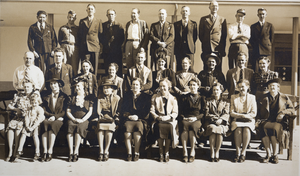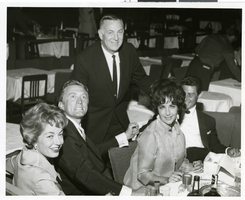Search the Special Collections and Archives Portal
Search Results

Postcard showing Death Valley Scotty at Scotty's Castle, Death Valley, circa 1920 to 1955
Date
1920 to 1955
Archival Collection
Description
Death Valley Scotty at his home of Scotty's Castle in Death Valley, California. Located within the far northern region of Death Valley in Grapevine Canyon, the Death Valley Ranch, more commonly known as Scotty's Castle, is a prime example of Spanish-Mediterranean styling during the Roaring '20s and Depression '30s. Scotty's Castle was constructed by Albert Johnson with the help of Death Valley Scotty during the Great Depression, but because the men began to build onto federal land, construction was forced to a halt. To this day, Scotty's Castle remains incomplete. Death Valley Scotty, 1872-1954, was a prospector, performer, and con man whose was made famous by his scams involving gold mining near Death Valley. In this postcard he is wearing a white shirt, black pants, an uneven tie, and a wide brimmed hat as he leans against a windowed door that acts as an entrance for his home. Transcribed onto the bottom border of the image: "Death Valley Scotty at Home, Scotty's Castle, Death Valley, California." The Frasher's Foto logo is printed onto the bottom right corner of the image.
Image

Postcard showing Scotty's Castle and Death Valley Scotty, Death Valley, California, circa 1930s
Date
1930 to 1939
Archival Collection
Description
A colored postcard showing an artist's representation of Scotty's Castle, Death Valley Scotty, and a stone covered in petroglyphs in Death Valley, California. Located within the far northern region of Death Valley in Grapevine Canyon, the Death Valley Ranch, more commonly known as Scotty's Castle, is a prime example of Spanish-Mediterranean styling during the Roaring '20s and Depression '30s. Death Valley Scotty, 1872-1954, was a prospector, performer, and con man whose was made famous by his scams involving gold mining near Death Valley. The petroglyph-covered rock beside Death Valley Scotty was designed by Native Americans who inhabited the valley hundreds of years ago. Transcribed across the borders of the image: "Death Valley National Monument, California; Death Valley Scotty And His Castle." The "Frasher's Foto" logo is branded upon the bottom right corner of the postcard.
Image

Photograph of a crowd of people associated with the Union Pacific Railroad, Las Vegas, 1940
Date
1940
Archival Collection
Description
A black and white image of a group of people associated with the Union Pacific Railroad sitting on benches for a photograph. From left to right, the individuals in the bottom row include: Mrs. A. L. Dixon, Miss L. Dixon, Mrs. C. M. Atherton, Mrs. G. R. Van Eaton, Mrs. Cooper, Mrs. M. L. Botts, Mrs. A. J. Schmidt, Mrs. H. S. Baldwin, Mrs. R. A. Gronberg, Mrs. P. H. Tingen, and Mrs. J. D. Forbes. From left to right, the individuals in the center row include: Mr. A. H. Dixon, Mr. T. C. Roberts, Mrs. R. A. Blonde, and Mrs. O. M. Barnett. From left to right, the individuals in the top row include: Mr. F. J. Jacomini, Mr. G. E. Casey, Mr. J. S. Letchworth, Mr. J. J. Logan, Mr. M. L. Botts, Mr. J. J. Logan, Mr. M. L. Botts, Mr. J. D. Forbes, Mr. H. S. Baldwin, Mr. G. R. Van Eaton, Mr. J. E. White, and Mr. R. A. Blonde. This photo was taken from a time capsule in the cornerstone of the Union Pacific Railroad station located in Las Vegas. The time capsule was placed there in 1940 and was later retrieved when the building was demolished around 1970.
Image

Photograph of several influential Las Vegans planting a tree in the courthouse park, Las Vegas, March 1911
Date
1911-03
Archival Collection
Description
Description given with photograph: "This photo was taken by C. P. Squires on the occasion of planting the first tree in the courthouse park, Las Vegas, Nevada. Date March 1911, as near as can be fixed. The building shown at left is the first Clark County Courthouse (now used for the LV City Library). Las Vegas City Library had been constructed by popular subscription by Las Vegas businessmen as promised by them during the county division campaign in 1908-1909. This building provided sufficient quarters for the county offices for five years, following which, the present courthouse was built. Persons shown, as far as their identity can be remembered are: (holding the tree) Ed W. Clark, (using the shovel) Judge E. L. Taber. Others, left to right: Charles Ronnow; Judge W. R. Thomas; unidentified; Bob Dillon; Frank A. Stevens; Harley A. Harmon and Dr. R. W. Martin (partly in picture)."
Image

Photograph of Anne Buydens, Kirk Douglas, Jack Entratter, Elizabeth Taylor and Eddie Fisher at a Four Chaplains memorial event, Las Vegas, February 7, 1960
Date
1960-02-07
Archival Collection
Description
L-R: Kirk Douglas and his wife Anne Buydens, Jack Entratter (standing), Elizabeth Taylor and Eddie Fisher at a Four Chaplains memorial event. Jack Entratter and the Sands Hotel hosted the event at the Las Vegas Convention Center on Four Chaplains Day, Sunday, February 7, 1960. The event featured Frank Sinatra, Dean Martin, Sammy Davis, Jr., Peter Lawford and Joey Bishop. Site Name: Las Vegas Convention Center (Las Vegas, Nev.); Sands Hotel and Casino
Image

Photograph of interior of the Aqueduct at the Sands Hotel and Casino, Las Vegas, 1963
Date
1963
Archival Collection
Description
An image of one of the hundred studio guest rooms at the Aqueduct at the Sands Hotel and Casino. The bi-fold closet doors were designed and constructed with Forest Burlite by the Like Mfg. Corporation in Downey, California and the carved design was chosen by the Albert Parvin Company in Los Angeles, California. The exterior of the hotel was designed by Julius Gabrielle, and the interior was designed by Albert Parvin & Company. Like all rooms at the Sands, this one had wall-to-wall, floor-to-ceiling drapes. A boucle-weave casement cloth under curtain eliminated the use of blinds. Outside draperies supplied most of the color accents in the room. Wall coverings in this room were of imported Japanese grass cloth. The table had a drop leaf which extended the surface to 72" x 30". All rooms featured antique-framed mirrors hung off center above 66-inch Mr. and Mrs. Chests. All guest room furniture was made in Barker Brother's factory.
Image

Film strip of Boulder City or Hoover Dam construction, image 001: photographic print
Date
1930 (year approximate) to 1939 (year approximate)
Archival Collection
Description
This photograph has three images. The first one, (0272_0002) reads, "Transports coming from dam-day shift. Climbing out the sides to be one of first in the commissary for a bottle of beer. It's been hot down there and they are thirsty," as a handwritten inscription. The second one, (0272_0003) reads, "One of several dorms that happened to be mine. (The arrow points to room) No grass to mow. One of its good points. Radios would not receive programs until early night, reason- no ground-no moisture in soil," in a handwritten inscription. The Six Companies Inc. dormitory housing 172 men, Boulder City, NV. The third picture, (0272_0004) which is upside down, reads "One pour wide getting in each other's way; hi-line moving catwalk soon will be finished," as a handwritten inscription on the image about the Hoover Dam under construction.
Image

Film strip of individuals or Hoover Dam construction, image 003: photographic print
Date
1930 (year approximate) to 1939 (year approximate)
Archival Collection
Description
This photograph has three images. The first one, (0272_0020) reads, "Personal pictures taken by Tommy Teas (my brother-in-law) of his work mates on #8 line. Bucket swinging, hard to spot. It hanging about 500 ft. Bell boy talking to operator who is out of sight on top of mountain," as a handwritten inscription. The second one (0272_0021) reads "Men building key, about 10 in. high and two ft. wide. (1) Bell boy getting a good sight to spot the bucket in the right place," as a handwritten inscription. The third one (0272_0022) is an upside down picture of the Dam. Its handmade inscription reads, "Still below river bed. Good look at a pouring crew (x) shows bell boy giving orders to operator. Nice shot showing how bucket works. After the bucket leaves, the men will walk all through the fresh mud to walk out any air pockets."
Image

Film strip of Boulder City or Hoover Dam construction, image 005: photographic print
Date
1930 (year approximate) to 1939 (year approximate)
Archival Collection
Description
This photograph has three images. The first one (0272_0023) has a handwritten inscription that reads, "Part of foundation for powerhouse" (on Boulder Dam). The second one (0272_0024) reads, "Arizona outlets for valve house on Boulder Dam. Penstocks protruding, waiting for the valve house to be built around them. (x) shows location of working tunnel to receive the pipes to put them in place. Will be plugged later." The third one (0272_0025) reads, "The Dam - indentation in canyon walls are for intake towers. Comparatively small down between the gigantic walls of Black Canyon. Still below river level, but looks like a lot of concrete to me. Train (x) on trussel, with 8 yds. bucket of mud, from lower mixing plant. Nice stroll across the catwalk ($) or better yet, try climbing that wig-wagging stairway wiggling up the canyon wall. I know a guy who did it (once)," as a handwritten inscription.
Image

Film strip of individuals or Hoover Dam construction, image 005: photographic print
Date
1930 (year approximate) to 1939 (year approximate)
Archival Collection
Description
This photograph has two images. The first one (0272_0038) reads, "No.7 hi-line 'My first job'. Showing all the old crew. I am seasoned by now. But Colette the boss (bottom right), on my first night, began to eat me out because I didn't know to follow the crew to next pour. Here stood a man as large as a bull, with a black eye and a hare-lip & bull-dog face, didn't fear me at all - all my fear was on that stuff going back and forth overhead." The second one (0272_0039) has an inscription that reads, "Good view of men working on No.8 hi-line - not up to the intake towers yet, but have dumped a lot of mud in this hole - good picture for night shift. A good action picture. Know all the men well - First there is Slim, Blackie, the man whose back we see is Whitie, the foreman then Tommie. My brother-in-law. There are four lines like this."
Image
Pagination
Refine my results
Content Type
Creator or Contributor
Subject
Archival Collection
Digital Project
Resource Type
Year
Material Type
Place
Language
Records Classification
